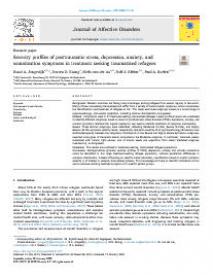Severity profiles of posttraumatic stress, depression, anxiety, and somatization symptoms in treatment seeking traumatized refugees
Background: Western countries are facing many challenges hosting refugees from several regions in the world. Many of them are severely traumatized and suffer from a variety of mental health symptoms, which complicates the identification and treatment of refugees at risk. This study examined subgroups based on a broad range of psychopathology, and several predictors, including trauma characteristics and gender.
Methods: Participants were 1147 treatment-seeking, traumatized refugees. Latent profile analysis was conducted to identify different subgroups based on levels of posttraumatic stress disorder (PTSD), depression, anxiety, and somatic symptoms. Multinomial logistic regression was used to identify predictors of subgroup membership.
Results: Three distinct subgroups were identified, reflecting Moderate (10.2%), Severe (43.0%), and Highly Severe (45.9%) symptom severity levels, respectively. Symptom severity of all psychopathology dimensions was distributed equally between the subgroups. Participants in the Severe and Highly Severe Symptoms subgroups reported more types of traumatic events compared to the Moderate subgroup. In particular, traumatic events associated with human right abuses, lack of human needs and separation from others predicted subgroup membership, as did gender.
Limitations: The results are confined to treatment-seeking, traumatized refugee populations.
Conclusions: Distinguishable symptom severity profiles of PTSD, depression, anxiety and somatic complaints could be identified in this large treatment-seeking refugee population, without qualitative differences in symptom distribution. Instead of focusing on specific mental disorders, classification based on overall symptom severity is of interest in severely traumatized patients. This knowledge will help to identify individuals at risk and to enhance existing treatment programs for specific patient groups.
Highlights
• A latent profile analysis in treatment seeking traumatized refugees was conducted
• Three distinct symptom severity subgroups were identified based on a broad range of psychopathology
• Trauma exposure, specific trauma events and female gender predicted subtype membership
• Severely traumatized patients should be diagnosed along a broadened framework of symptomatology
• Treatment should focus on this broad framework, as well as on post-migration distress
Geachte bezoeker,
De informatie die u nu opvraagt, kan door psychotraumanet niet aan u worden getoond. Dit kan verschillende redenen hebben,
waarvan (bescherming van het) auteursrecht de meeste voorkomende is. Wanneer het mogelijk is om u door te verwijzen naar de bron
van deze informatie, dan ziet u hier onder een link naar die plek.
Als er geen link staat, kunt u contact opnemen met de bibliotheek,
die u verder op weg kan helpen.
Met vriendelijke groet,
Het psychotraumanet-team.
266 | april | 71-81
https://doi.org/10.1016/j.jad.2020.01.077


